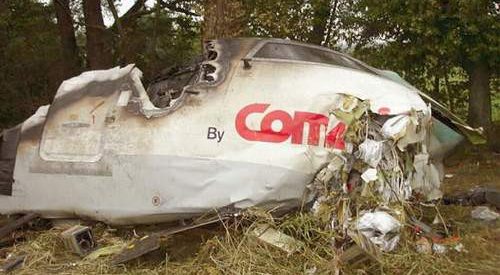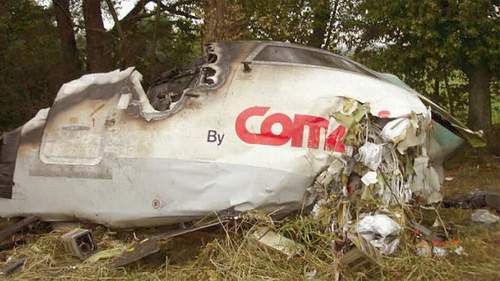 The cockpit of flight 5191 lies in a field after the crash. (Public domain image)
The cockpit of flight 5191 lies in a field after the crash. (Public domain image)
On the 27th of August 2006, a routine commuter flight to Atlanta, Georgia failed to become airborne during its takeoff roll at Blue Grass Airport in Lexington, Kentucky. The CRJ-100 ran off the end of the runway, lifted off momentarily, then smashed into an embankment, a fence, and a grove of trees. The plane broke apart and slid to a stop in a field, consumed in flames. Little remained of the jet, but police officers who rushed to the scene managed to find a survivor ? First Officer James Polehinke, badly injured but alive, trapped in the remains of the cockpit. Of the 50 on board, all 49 others perished in the impact and the flames that followed. But for Polehinke, his survival turned out to be more a curse than a blessing ? in fact, from the very beginning, it was clear that he had made an inexplicable error. Somehow, Comair flight 5191 had attempted to take off on the wrong runway ? a confounding mistake that nobody, not even the NTSB, could fully explain. The investigation into the perplexing accident came to an unsatisfying conclusion which reminds us that the human mind is more fallible than we would like to believe.
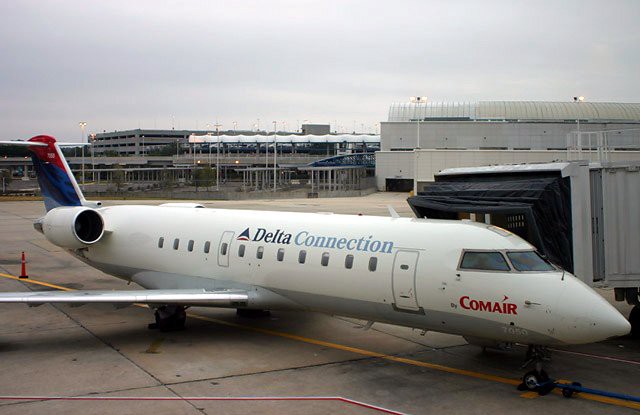 A Comair/Delta Connection CRJ-100 similar to the one involved in the accident. Image source: David Mueller
A Comair/Delta Connection CRJ-100 similar to the one involved in the accident. Image source: David Mueller
Comair was a wholly owned subsidiary of Delta Air Lines that operated a large network of short, regional flights beginning in 1977. Tickets on Comair flights were sold under the brand name Delta Connection, a common practice for regional carriers whose routes feed into the networks of big US domestic airlines. One such flight was Comair 5191, a short trip from Lexington, Kentucky to Atlanta, Georgia early on the morning of the 27th of August 2006. In command of the flight were Captain Jeffrey Clay, 35, and First Officer James Polehinke, 44, both relatively experienced pilots who had received nothing but praise from those who worked with them. Neither had any history of mistakes or violations. Overall, they were no different from any other pilots ? just two men doing their jobs to the best of their ability.
The plane they would be flying that day was a Canadian-made Bombardier CRJ-100, a popular short range jet with two tail-mounted engines and room for 50 passengers. Today?s flight was almost full: shortly before 6:00 a.m., 47 passengers boarded the plane, joining the two pilots and a flight attendant for a total of 50 occupants. All indications were that the flight would leave on time at around 6:05.
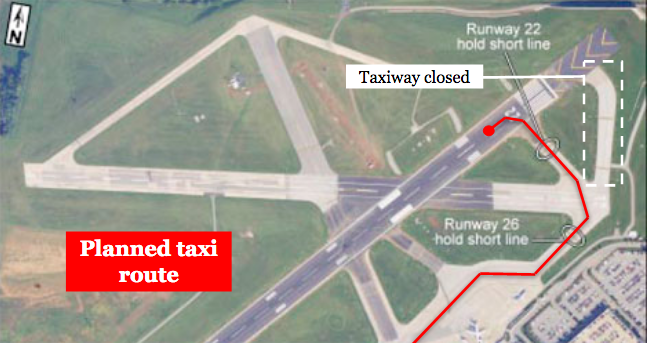 Where flight 5191 should have taxied. Image source: the NTSB
Where flight 5191 should have taxied. Image source: the NTSB
Shortly after 6:00, flight 5191 taxied away from the gate and into the pre-dawn darkness. Like all commercial flights at Lexington airport, they planned to take off on runway 22, the airport?s only runway capable of handling passenger jets. Getting there should have been incredibly simple: they would taxi across the apron, then follow taxiway A until they reached runway 22. While following taxiway A, they would cross the threshold of runway 26, a short runway used by small, private aircraft that crosses runway 22 at a 40-degree angle. Both pilots had taken off from Lexington at night before and were somewhat familiar with the airport. Captain Clay apparently felt confident enough that he abbreviated the taxi briefing to a quick statement that they would use ?Comair standard,? even though he technically was supposed to discuss the entire taxi route. First Officer Polehinke did go over the route during the takeoff briefing before starting the engines, but he didn?t include crossing runway 26, even though he was looking at a map that showed this. He likely didn?t consider it important enough to mention.
At the gate and while taxiing, the pilots carried on a running conversation about topics ranging from their wives and kids to Comair?s hiring practices, periodically interrupting themselves to announce checklist items. This violated the ?sterile cockpit rule,? a longstanding regulation prohibiting pilots from engaging in non-pertinent conversations after engine start and below an altitude of 10,000 feet. In these critical phases of flight, any off-topic discussions could distract them from important duties.
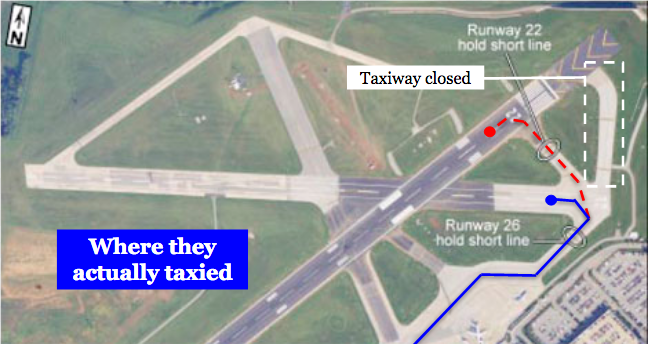 Where they should have gone versus where they actually went. Image source: the NTSB
Where they should have gone versus where they actually went. Image source: the NTSB
After a minute or two, flight 5191 arrived at the junction of taxiway A and runway 26. The crew stopped the plane and sat there for 50 seconds, making final preparations for takeoff. Captain Clay made an announcement to the passengers and told the flight attendant to prepare the cabin. First Officer Polehinke ran through a few final settings. Moments before 6:06, Captain Clay taxied the airplane onto runway 26, but instead of crossing it, he turned left and lined up with the runway! He then transferred control to First Officer Polehinke, who announced, ?My brakes, my controls,? and accelerated the engines to takeoff thrust. They were surrounded by signs that they were on runway 26, not the assigned runway 22. There were markings on the pavement and signs posted next to the runway. The pre-set heading indicators (or ?bugs?) on their compasses weren?t aligned with their actual heading. Runway 26 lacked edge lighting and specialized markings, both of which were present on runway 22. And yet, the pilots appeared to miss every one of these cues.
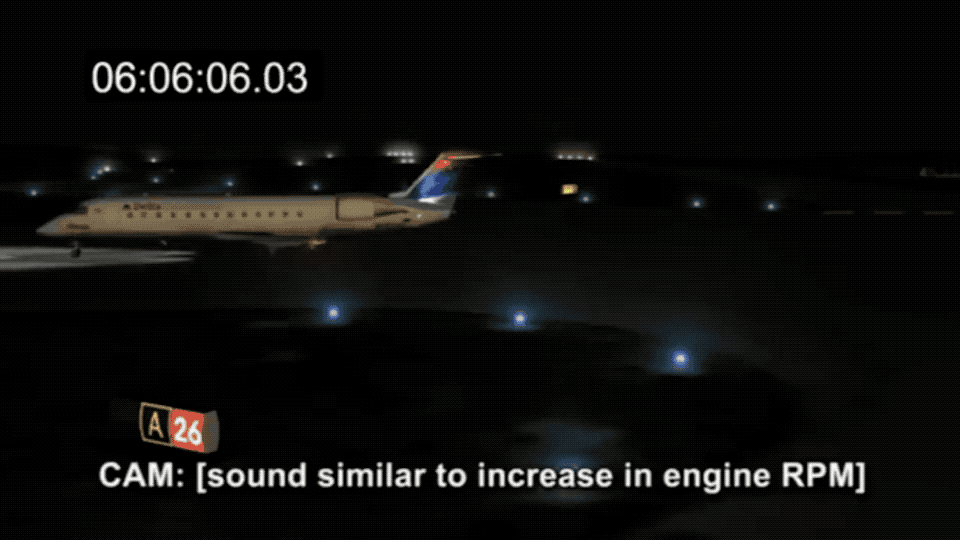 A simulation of the takeoff, with the cockpit voice recorder transcript overlaid. Video source: Eyewitness Animations
A simulation of the takeoff, with the cockpit voice recorder transcript overlaid. Video source: Eyewitness Animations
Runway 26 was only 1,067 meters long, less than the length needed for a CRJ-100 to get off the ground, let alone the length that was legally required. Only airplanes weighing less than 5,670 kilograms were allowed to take off or land on it, rendering it usable only by small single-engine airplanes. In 17 years working at Lexington Airport, the air traffic controller on duty that night had never seen a commercial airliner use runway 26. Having already cleared flight 5191 to take off, he turned away from the window and set about finishing an administrative record-keeping task, unaware that a fully loaded airliner was attempting to take off on a runway that was too short.
Flight 5191 accelerated towards what would later be described as a ?black hole.? The lighting conditions at that time of night created an intensely dark horizon that made it impossible to tell how long the runway was. About ten seconds into the takeoff roll, Polehinke commented, ?That is weird with no lights.?
?Yeah,? said Captain Clay. He then called out ?100 knots? (185kph). Although they didn?t know it, they had now passed the maximum speed at which they could safely stop on the runway.
Seven seconds later, Clay apparently realized that they were about to run out of room and announced, ?V1, rotate!? well before reaching the speed at which they would normally start to lift off. At that point there were less than 100 meters of runway remaining.
?Whoa,? Clay suddenly exclaimed. At that moment flight 5191, traveling at over 240 kilometers per hour, ran off the end of the runway and bounced across the grass overrun area. First Officer Polehinke immediately pulled his control column all the way back in a desperate attempt to climb. Clay uttered an expletive. A split second later, the main landing gear smashed into an earthen berm 80 meters past the end of the runway, sending the plane momentarily airborne. The tail section crushed the airport perimeter fence, then the plane briefly touched down in a field before bouncing back into the air. Stall warnings blared as the pilots made a series of unintelligible exclamations of surprise and terror. Flight 5191 then plowed into a stand of trees, snapping them off barely two meters above ground level. The fuel tanks ripped open and their contents ignited on the spot. Engulfed in flames, the plane crashed back to earth and slid for 120 meters before careening into another grove of trees, which shredded the fuselage and instantly killed numerous passengers. The mangled wreckage finally came to a stop on the edge of a horse pasture, surrounded by a raging fire.
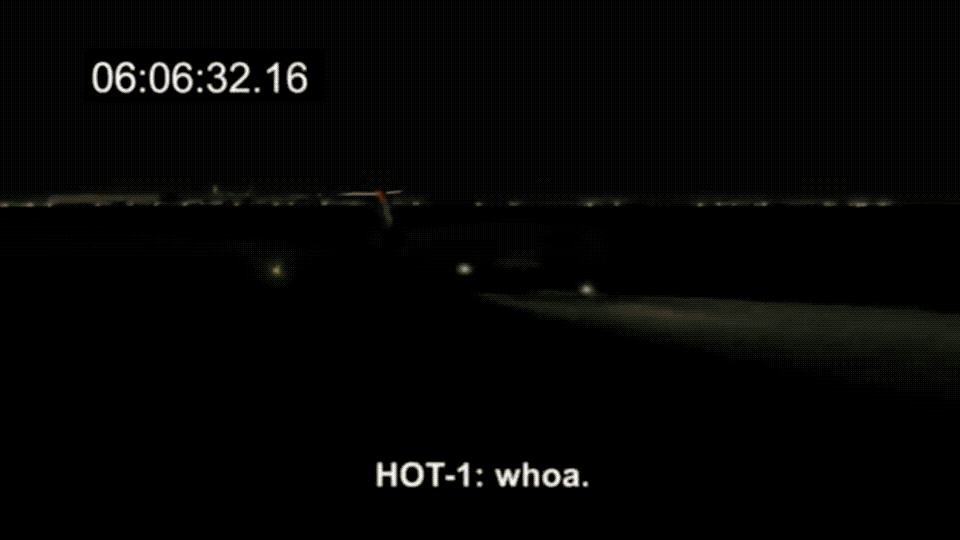 Simulation of the crash. Video source: Eyewitness Animations
Simulation of the crash. Video source: Eyewitness Animations
The impact outright killed 27 of the 50 people on board, including Captain Clay, who was ripped out of the cockpit from underneath and thrown into the passenger cabin. Most of the remaining 23 passengers and crew also never had any chance to escape. Within a very short period, likely 30 seconds or less, 22 more people perished amid the smoke and flames, some from burning and some from smoke inhalation. Most never made it far from their seats, and no one ever attempted to open an emergency exit ? there simply wasn?t enough time.
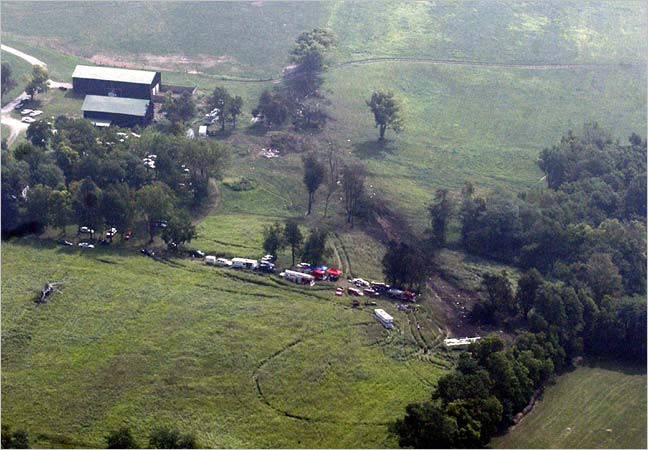 An aerial view of the crash site. Image source: the New York Times
An aerial view of the crash site. Image source: the New York Times
In the control tower, the controller heard a loud sound and looked up to see an explosion off the end of runway 26. Believing that flight 5191 had somehow turned hard to the right and crashed on takeoff from runway 22, he picked up the crash phone and informed emergency services that the jet had crashed off the west side of the airport, just off the approach end of runway 8. It would be many hours before the controller learned that the plane had attempted to take off on the wrong runway.
Meanwhile, a local police officer and a public safety officer from the city of Lexington were the first to arrive on the scene of the crash. They found the plane consumed in flames, with the exception of the cockpit, where they discovered an unconscious James Polehinke still strapped into the shattered remains of his seat. They managed to extract him from the mangled cockpit, and due to his grievous injuries, the police officer decided to load him into his SUV and take him to the hospital right away instead of waiting for an ambulance.
 The ruined cockpit from which Polehinke was pulled alive. Image source: the NTSB
The ruined cockpit from which Polehinke was pulled alive. Image source: the NTSB
While the police rushed Polehinke to the emergency room, firefighters arrived at the crash site and quickly brought the fire under control. But a search of the wreckage soon led to a grim conclusion: none of the other 49 passengers and crew had survived. James Polehinke, the man who was flying the plane at the moment it crashed, would be the only one left to tell the story.
He would never really get to tell the story, however. Like many people who go through extremely traumatic experiences, his mind blacked out the trauma and he could remember nothing after lining up with the runway. And he was physically traumatized as well as mentally. His injuries forced the amputation of his left leg, and he lost motor control over his right leg as well due to spinal cord damage. He would likely never walk again, and certainly would never go back to flying airliners. Everything had been taken from him ? and then he had to be told that not only was he the only survivor, he was accused of having lined up with the wrong runway for takeoff.
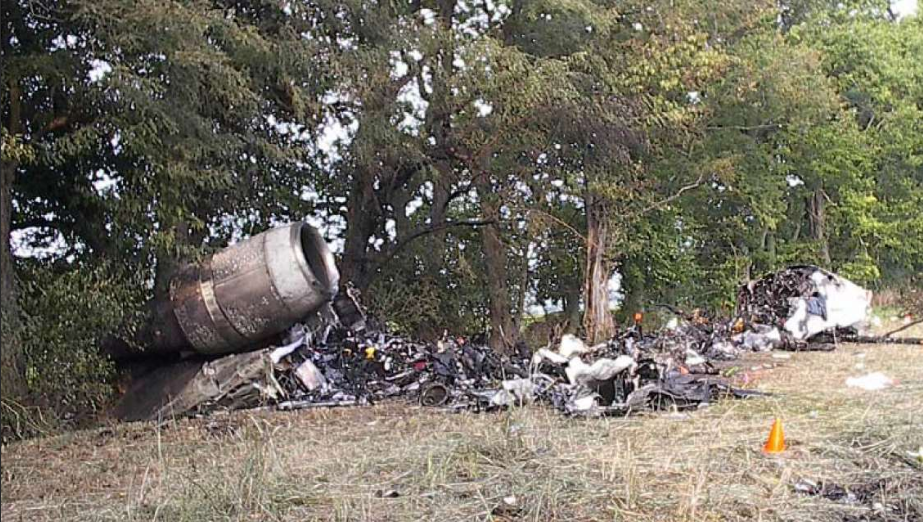 The burned out remains of the passenger cabin testify to the intensity of the post-crash fire. Image source: the NTSB
The burned out remains of the passenger cabin testify to the intensity of the post-crash fire. Image source: the NTSB
It?s useful to remember that no pilot involved in an accident, no matter how egregious their error appears in hindsight, went to work that day thinking that they would do anything other than follow the rules and get everyone to their destination safely. The same was true of Clay and Polehinke. No one could dispute that they were good pilots who cared about doing their job well. A review of records relating to both men and Comair could find nothing wrong with their performance, their training, the airline, or its federal oversight. The investigation had to look at subtler factors that could have misled the pilots in the critical minutes while they taxied to the runway. There was, of course, the violation of the sterile cockpit rule ? but as investigators and pilots willingly admit, the sterile cockpit rule is violated all the time. Although media reports made much of their non-pertinent conversation, in truth it could hardly be described as a scandal, and it certainly didn?t cause the crash all on its own.
 The tail section with the engines was one of the only recognizable parts of the plane. Image source: the NTSB
The tail section with the engines was one of the only recognizable parts of the plane. Image source: the NTSB
Many other factors also existed. The pilots hadn?t discussed the fact that they would need to cross runway 26. Nor did the controller explicitly clear them to taxi across it; rather, by clearing them to taxi to runway 22, the controller conferred an implicit clearance to cross runway 26 as well. So, perhaps the pilots were not in a ?head space? where they would have to deal with runway 26. Why then did they not notice they were in the wrong place? Numerous signs indicated that they were lined up for runway 26, not runway 22. But a few could have given them the opposite indication. The layout of the holding points beside the two runways appeared similar. The sign painted on the surface of runway 26 did not contrast sharply enough with its background, and would have been out of sight beneath the plane after they taxied into position. Although the pilots had set the heading bugs on their compasses to 227 degrees, aligning with runway 22, it wasn?t standard procedure at Comair to check these before takeoff. And the absence of certain lights would not have immediately raised red flags ? in fact, on his flight into Lexington Polehinke had noticed that some of the lights on runway 22 weren?t working, and this was reflected in notices issued to the crew that very morning.
Taking all these factors together, it seems possible that the pilots missed signs that they were on runway 26 due to confirmation bias. Believing they were lining up with runway 22, their brains were primed to absorb information that confirmed this belief, which was reinforced by the coincidences described above. The human mind is not good at processing information that undermines previously held beliefs, so it?s possible that contradictory cues like the signs alongside the runway simply never registered.
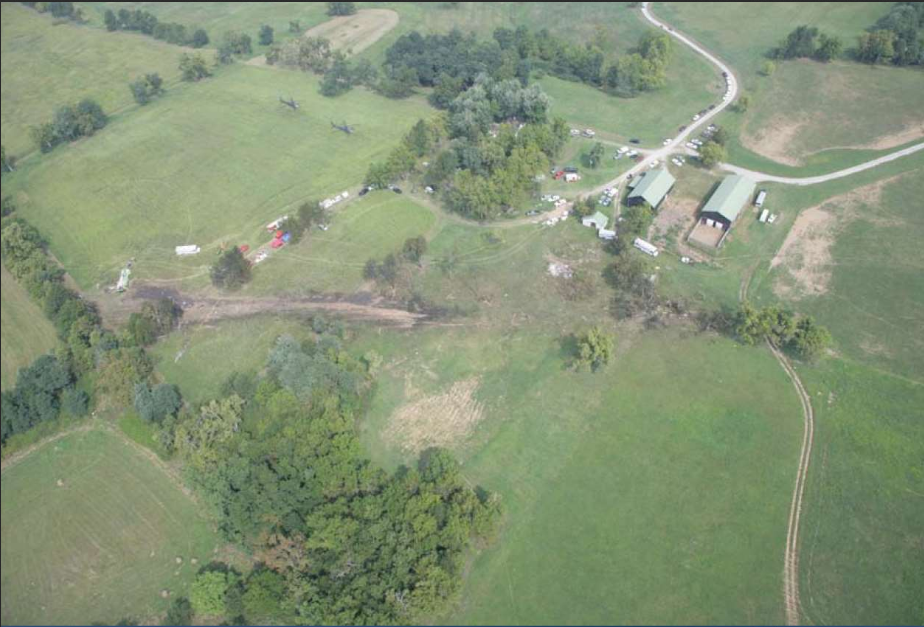 Another aerial view of the crash site. Image source: the NTSB
Another aerial view of the crash site. Image source: the NTSB
While there were plausible reasons why the pilots didn?t notice their mistake, the NTSB was unable to explain why they lined up with the wrong runway in the first place. They didn?t appear to be suffering from fatigue. They never expressed confusion about their location. Except for a few minor infractions like the off-topic conversation, they didn?t deviate from standard operating procedures. One can only conclude that they succumbed to some quirk of the human mind, in a brief moment of distraction skipping a step on their mental road map upon perception of some subtle, subconscious cue. We are all vulnerable to such mistakes, and afterwards we rarely understand why we made them. When we inexplicably grab the wrong utensil when cooking or accidentally start taking our dirty dishes to the bathroom instead of the kitchen, we should be thankful that we aren?t responsible for a plane full of people.
Ultimately it is the captain?s job to maintain a cockpit environment that is serious and professional, thereby reducing the chances of casual errors. Captain Clay and First Officer Polehinke seemed to have a very relaxed relationship, with Clay using the phrase ?at your leisure? repeatedly, and agreeing to engage in off-topic conversation initiated by Polehinke. But there is a delicate balance to be performed: a cockpit that is too formal or too sterile lacks the dynamic energy that a crew needs to work together effectively. Pilots draw the line in different places, and there are pros and cons to both approaches. Whether the casual cockpit atmosphere contributed in any way to the outcome is a matter of opinion.
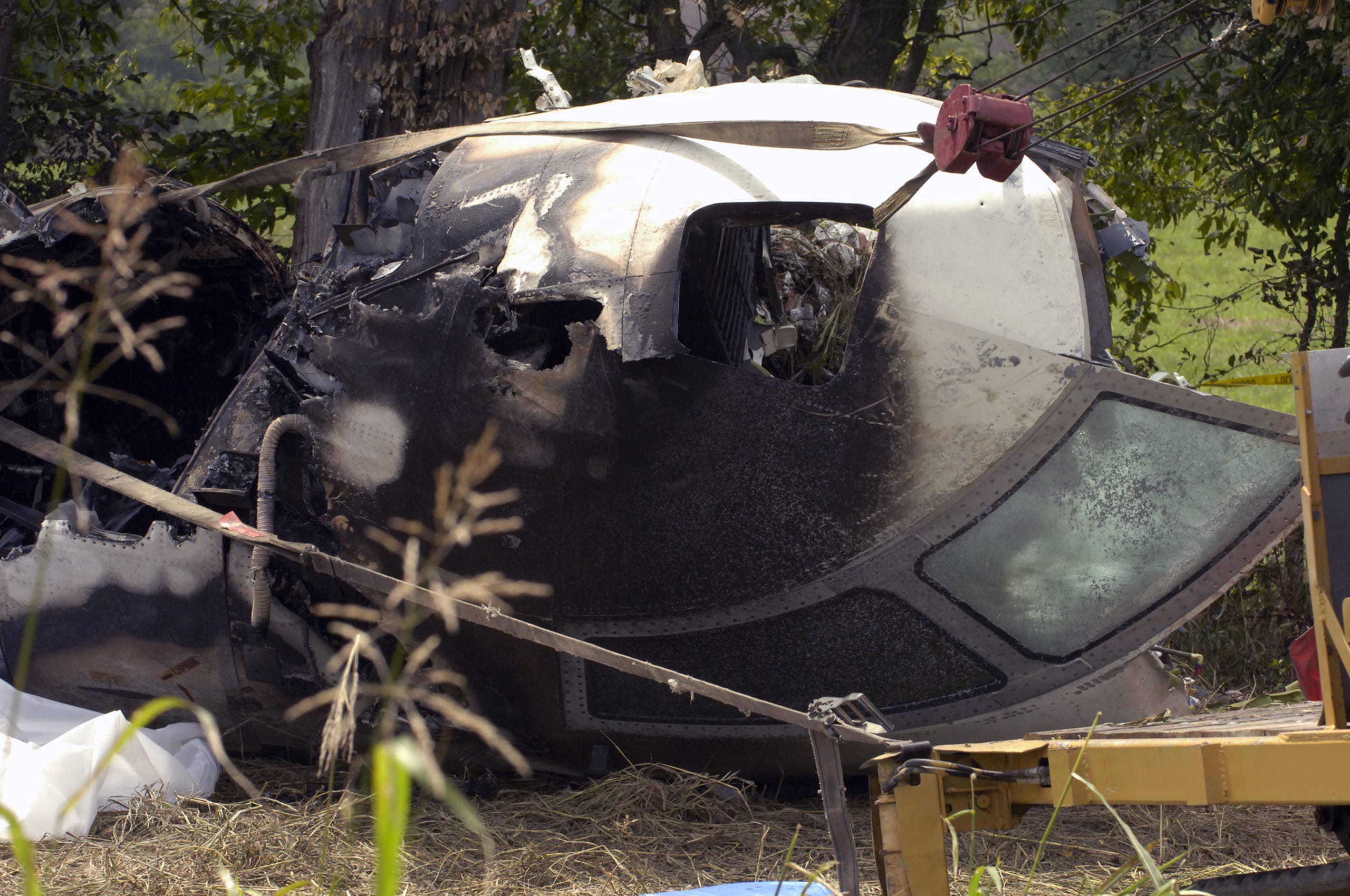 Recovery crews prepare the charred cockpit for transport. Image source: the Louisville Courier-Journal
Recovery crews prepare the charred cockpit for transport. Image source: the Louisville Courier-Journal
Because it?s impossible to expect a pilot to never make a mistake, redundant systems exist to ensure that mistakes are caught and corrected quickly. Clearly in this case those systems failed, and the NTSB had much to say about this. First, there were opportunities for the controller to notice that flight 5191 was on the wrong runway. Although it was difficult to see from the control tower whether a plane was holding short of runway 26 or runway 22, there was a further 28-second window of opportunity during which it would have been obvious that the jet was taking off on the wrong runway. Had the controller glanced out his window at any point during this period, he could have seen what was happening and ordered flight 5191 to abort its takeoff with room to stop on the runway. Tragically, the controller had turned his attention to an administrative task that prevented him from monitoring the takeoff. Although the NTSB believed that monitoring takeoffs is important for safety reasons, controllers often don?t do this unless they have absolutely nothing else to do. In this case, the controller needed to perform a traffic count before his shift ended at 6:30, and he gave this a higher priority even though it was unrelated to safety.
The controller also shouldn?t have been alone in the tower. The FAA had previously issued verbal guidance requesting that two controllers be on duty during the midnight shift, but at many airports this policy was applied inconsistently. The controller was also likely suffering from fatigue, since he had slept for only 2 of the last 24 hours, and the accident occurred during his circadian low. A second set of eyes in the control tower could have compensated for this and perhaps prevented the accident.
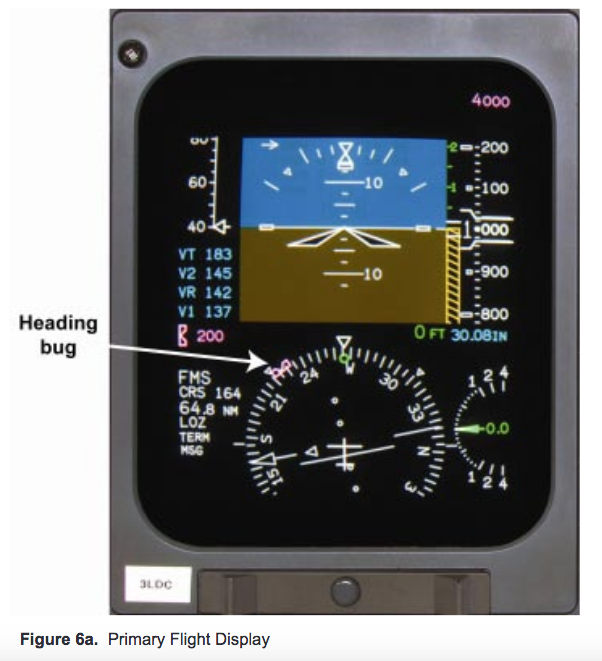 How a heading bug works. Image source: the NTSB
How a heading bug works. Image source: the NTSB
The crash could also have been prevented if the pilots had checked to see if their heading bugs matched with their actual heading before taking off. (A ?bug? is an adjustable marker overlaid on an instrument to remind pilots of a target value.) In fact, many airlines in the United States included this as a standard step in their before takeoff checks ? and with good reason. In 1983, a Korean Air Cargo DC-10 took off on the wrong runway in Anchorage, Alaska, resulting in a collision with a Piper PA-32 that injured nine people and destroyed both aircraft. As a result of that accident, the NTSB recommended that all air carriers incorporate a cross-check of the heading bug before takeoff. In response, the FAA issued a non-binding request to use such a procedure, and most airlines complied. But while investigating the Comair crash, the NTSB was surprised to learn that many airlines had not in fact done so. If Comair had made this check standard after the Anchorage accident, the crash in Lexington almost certainly would not have happened.
The accidents in Alaska and Kentucky were not the only instances of air crews taking off on the wrong runway. In 2000, Singapore Airlines flight 006 attempted to take off on a closed runway at Taipei?s Chiang Kai-shek International Airport. The Boeing 747 struck construction equipment and broke apart, killing 81 of the 179 people on board. There had also been several cases of successful wrong-runway takeoffs in the preceding years in the United States. The number of times that planes lined up with the wrong runway but did not take off was much higher. Between 1988 and 2006, the NTSB had recorded 114 such cases in the US alone. This figure included one case at Lexington Airport: in 1993, a flight cleared to take off from runway 22 instead lined up for runway 26, but an accident was prevented when the crew checked their heading bugs and realized they were facing the wrong way. The pilots of that flight later described that part of the airport as ?confusing,? an assessment with which airport employees agreed. Compounding the problem were outdated charts, still in widespread use, which didn?t depict the interim taxiway layout being used at the time due to construction work. Although the pilots of flight 5191 never taxied into the area of the mismatch, it definitely added to the milieu of factors making what should have been a simple taxi route more complicated than expected. Looking back, some believe that a wrong-runway takeoff at Lexington was not just plausible, but inevitable.
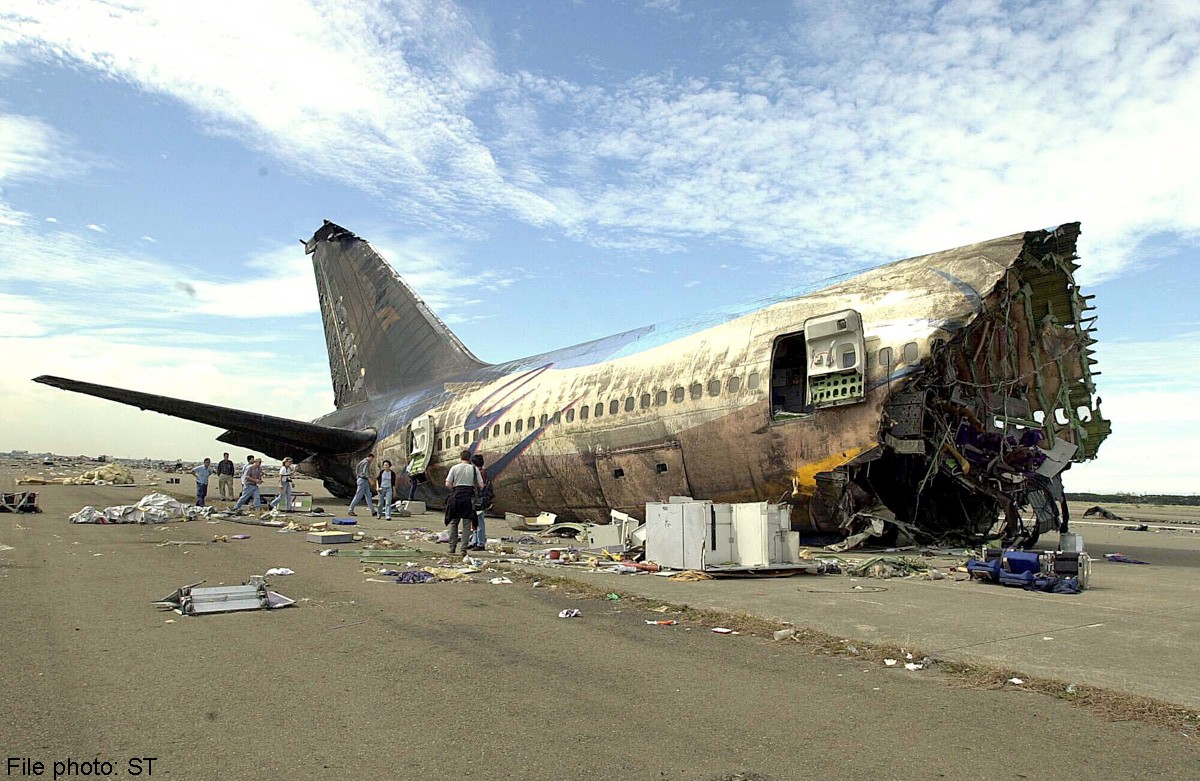 The wreckage of Singapore Airlines flight 006 lies on the runway after the crash in October 2000. Image source: Asia One
The wreckage of Singapore Airlines flight 006 lies on the runway after the crash in October 2000. Image source: Asia One
The nuance of the situation unfortunately was lost on many. The media largely blamed the pilots without recognizing that mistakes are never made in a vacuum. The angry response to the crash proved so toxic that James Polehinke received death threats before he had even left the hospital. And while he always tries to point out the mitigating factors, he does not hesitate to recognize the role he played in the crash. In the 2012 documentary ?Sole Survivor,? his wife tearfully stated, ?He by no means pulled the long straw and won the lottery because he got to live. First of all, he would have rather died. His conviction as a pilot was so great that he would have rather gone down with the ship?. It?s such an emotional cross that he bears, that no one really sees but me. He would have given anything to have gone with all of them.?
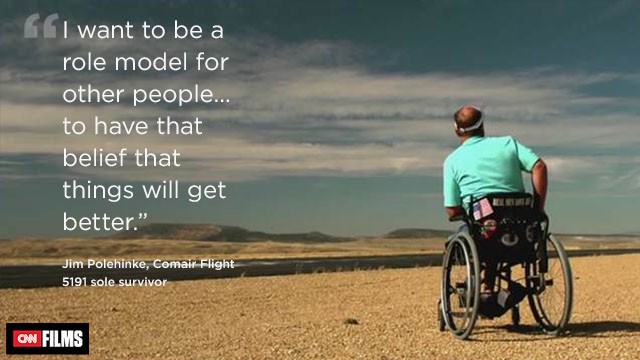 Polehinke tries to maintain a positive attitude going forward. Image source: CNN
Polehinke tries to maintain a positive attitude going forward. Image source: CNN
Polehinke doesn?t think he?ll ever forgive himself. ?The people that came on board the plane were my responsibility,? he said, admitting that he failed them. But the depression and anger that he faced in the first years after the crash eventually gave way to a frank acceptance that he had survived, and that he had best make use of this second chance at life. As of 2012, he had made it his life goal to ski in the Paralympics.
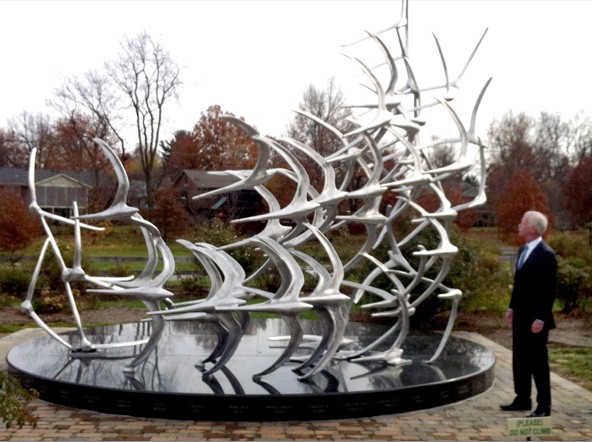 Chesley ?Sully? Sullenberger visits the memorial to the victim of Comair flight 5191. Image source: Chesley Sullenberger
Chesley ?Sully? Sullenberger visits the memorial to the victim of Comair flight 5191. Image source: Chesley Sullenberger
In its final report, the NTSB again recommended that the FAA require crews to verify that they?re lined up with the correct runway before takeoff. As of 2014, the FAA appeared ready to comply with this recommendation. Second, the NTSB recommended that operators install cockpit moving map displays that will show a plane?s position within the airport at all times. The FAA subsequently created guidelines that such systems must meet, but left it up to airlines to install them voluntarily; as a result, use of such devices is patchy. Third, the NTSB recommended that controllers refrain from clearing a flight for takeoff until it has crossed all intervening runways, and that individual clearances be provided before crossing those runways, a recommendation which the FAA had rebuffed after its original issuance in 2000. This time, the FAA changed its mind, and as of 2012 both of these procedures have been adopted nationwide. Thanks to these changes, the chances of a similar accident occurring in the future have been greatly reduced. But like so many improvements before them, they came at great cost ? not just to those who lost their lives, but also to the sole survivor, who will forever struggle with the unwelcome burden of responsibility.
____________________________________________________________
Click here to join the discussion of this article on reddit!
Visit r/admiralcloudberg to read more than 100 similar articles.
